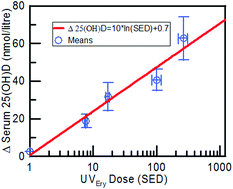Serum 25-hydroxyvitamin-D responses to multiple UV exposures from solaria: inferences for exposure to sunlight
Abstract
We investigate the relationship between blood serum 25-hydroxyvitamin D (25(OH)D) and UV exposure from two artificial sources. We then use the results to test the validity of the action spectrum for vitamin D production, and to infer the production from summer and winter sunlight. The results are based on a two-arm randomised clinical trial of biweekly UV exposure for 12 weeks using two different types of dermatological booths: one emitting primarily UV-A radiation, and the other emitting primarily UV-B radiation (booth A and booth B respectively). In terms of the vitamin D production per unit erythema, one of the booths mimics summer noon sunlight, while the other mimics winter noon sunlight. Blood samples were taken before and after the exposures. For all participants, the phototherapy booth treatments arrested the usual wintertime decline in 25(OH)D, and for most the treatments from either booth resulted in significant increases. The increases were highly non-linear and there was a high degree of variability in 25(OH)D and its response to UV from person to person. By the end of the 12 week period, the mean increase was >30 nmol l−1 from a cumulative exposure of 17 SED from the UV-A booth, and twice that for the UV-B booth for which the cumulative exposure was 268 SED. Assuming a logarithmic relationship between UV and vitamin D, the results for the two booths show no obvious inconsistency in the action spectrum for pre-vitamin D production. However, further measurements with similar exposures from each booth are required to confirm its validity. A model was developed to describe the increases in serum 25(OH)D resulting from the UV exposures, which differed markedly between the two booths. The deduced initial rate of increase of 25(OH)D was approximately 5 nmol l−1 per SED. From the large increases in 25(OH)D from each booth, along with knowledge of the spectral distribution of sunlight and assuming the currently-accepted action spectrum for photo-conversion to pre-vitamin D, we infer that the production of 25(OH)D from sunlight should be possible throughout the year, although in winter the exposures necessary to maintain optimal levels of 25(OH)D would be impractically long. This finding is at variance with the commonly-held view that no vitamin D is produced at mid-latitudes in the winter. Further work is needed to resolve that inconsistency.


 Please wait while we load your content...
Please wait while we load your content...